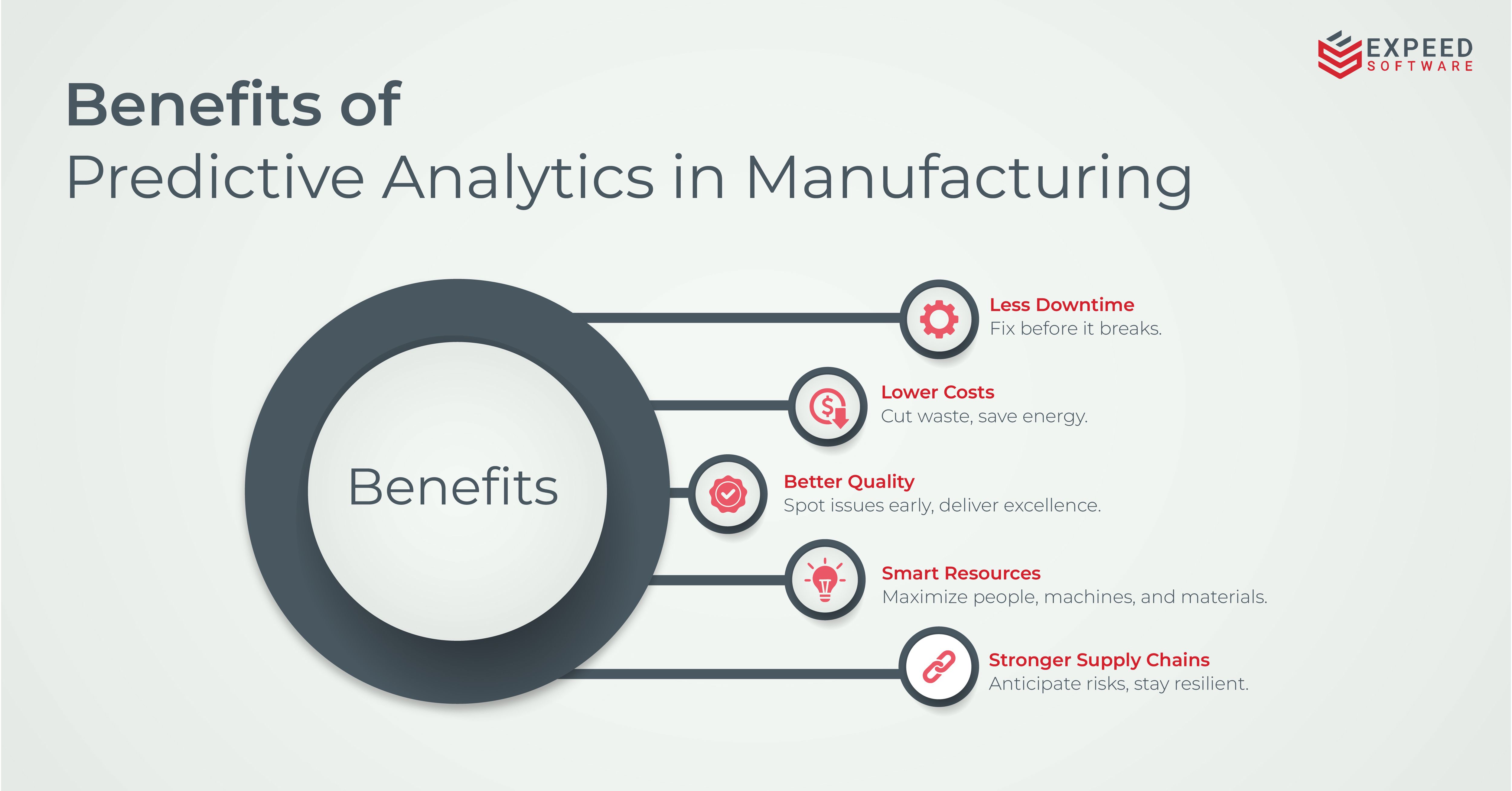Top Use Cases of Predictive Analytics in Manufacturing
Predictive Maintenance
Equipment downtime is one of the biggest issues that can cost manufacturers a lot of money. Predictive maintenance utilizes machine logs, sensor data, and functional history to identify probabilities of machine failure. It identifies issues in advance so that maintenance teams can react right away instead of maintaining machine servicing on a set schedule. Maintenance teams can quickly take preventive actions in line to tackle abnormal or faulty performance. This helps reduce unplanned machine downtime and extends the lifecycle of expensive machinery.
Quality Control Optimization
When it comes to quality, predictive analytics can spot issues before they escalate. It monitors production line data, historical patterns of quality defects, and environmental conditions so manufacturers can take action at the root of the issues and early stages of defects. For instance, if a machine starts making components that are slightly out of specification, the system automatically triggers alerts to make adjustments before the whole batch is compromised.
Demand Forecasting
Accurate demand forecasting with predictive analytics helps avoid overproduction and stockouts simultaneously. It processes past sales information and even weather patterns to predict product demand across the market. This can help production schedules to come in line with market shifts, reducing wastage and costs.
Supply Chain Risk Management
Even a well-designed and established supply chain can be impacted by delays, shortages, or shifting demand. Predictive analytics can help identify potential risk vectors like supplier delays or geopolitical catastrophes, allowing businesses to take preventive measures, adapt inventory strategies, or even procure from alternative suppliers.
Energy Consumption Optimization
Energy costs contribute to a large part of manufacturing costs. Predictive analytics analyzes patterns across machinery or sites that facilitate optimizing energy consumption while also reducing waste and operating expenses. If energy consumption tracking identifies peak usage times, manufacturers can shift operations to off-peak hours, boosting profitability and enhancing sustainability goals.
Inventory Management
Managing inventory with predictive analytics turns a reactive process into a finely tuned system. Manufacturers can anticipate exactly when raw materials will be needed, ensuring the right materials arrive at the right time. This precision prevents overstock, avoids costly shortages, and keeps operations flowing without interruption.
Production Scheduling
With predictive analytics, production scheduling will be far more accurate and flexible. It takes demand forecasts, machine performance, labor availability, and supply chain timing to develop a schedule that effectively manages operations. This ultimately reduces idle time, minimizes bottlenecks, and maximizes throughput.
Tips for Implementing Predictive Analytics in Manufacturing

1. Start with Clear Goals
Before investing in predictive analytics tools, define what you want to achieve — whether it’s reducing downtime, improving quality, or optimizing supply chains. Clear goals guide your data collection and model selection.
2. Invest in Data Quality
The accuracy of predictive insights depends on the quality of your data. Ensure that sensor data, operational logs, and other inputs are clean, consistent, and up to date.
3. Integrate with Existing Systems
Predictive analytics works best when integrated into your ERP, MES, or maintenance management systems. Seamless integration ensures that insights lead directly to actionable workflows.
4. Train Your Team
Analytics tools are powerful, but they require skilled operators. Invest in training so that engineers, operators, and decision-makers can interpret results and apply them effectively.
5. Start Small and Scale
Begin with one or two use cases, measure results, and then expand. This minimizes risk and allows your team to build confidence with the technology.
Benefits of Predictive Analytics in Manufacturing

1. Reduced Downtime
When maintenance is planned, production stays on track. Predictive insights into equipment health let manufacturers slot repairs into planned downtime, avoiding disruptive breakdowns and safeguarding continuous production flow.
2. Cost Savings
While optimizing maintenance, waste is reduced, and energy is managed wisely. Predictive analytics quickly becomes self-funding by removing operational inefficiencies.
3. Higher Product Quality
Spotting quality issues before they escalate ensures every product meets standards. It cuts down on rework and returns while boosting brand image.
4. Better Resource Utilization
With predictive analytics, every resource, from people to materials to machines, is used efficiently, delivering higher productivity without straining day-to-day operations.
5. Stronger Supply Chain Resilience
By foreseeing supply chain issues, manufacturers can take prompt actions, safeguarding production flow and supporting customer needs during challenging times.
6. Increased Customer Satisfaction
On-time deliveries, consistent quality, and reliable product availability foster customer trust. Predictive analytics plays a key role in maintaining this consistent performance.
Challenges of Predictive Analytics in Manufacturing
1. Data Integration Complexity
Manufacturers may often have several systems running concurrently, and each system has its own data format. Getting the data consolidated and standardized for predictive analytics can be difficult and take a fair amount of time if you don't have the necessary infrastructure.
2. Initial Upfront Costs
Using the real-time sensor monitoring, upgrading the system, and training staff all have an initial investment. Despite a great ROI, upfront costs can be a major consideration for smaller manufacturers.
3. Skill Gaps
Not every manufacturing group has its own analytics or data science expertise, and unless you have access to skilled talent or external partners, it may take longer to implement.
4. Data Security Concerns
Having more data collected and analyzed raises data control issues. Manufacturers require robust cybersecurity policies in place to avoid breaches that can lead to unauthorized disclosure of private data.
5. Resistance to Change
Not every team is ready to jump into predictive analytics. Sometimes teams choose to limit their capabilities to traditional methods over any changes. The key is clear communication and staff training that creates confidence.
Where Expeed Software Stands
At Expeed Software, we help manufacturers transform data into meaningful insights. We address current manufacturing problems with advanced AI, IoT systems, data engineering, and custom solutions. Whether it is reducing machine downtime, improving your supply chain, or creating products with less mayhem, we create solutions that provide real value. We help manufacturing leaders take a stronger and more confident footing in decision-making and business operations while mixing real-world experience with smart analytics.
Final Words
In the fast-paced and competitive industrial landscape, predictive analytics in manufacturing has become more than a "nice-to-have" — it is a must-have! It enables manufacturers to turn raw data into meaningful insights that let them predict issues, drive quality, optimize functions, and stay competitive. Predictive analytics in manufacturing facilitates continuous product improvement, effective supply chain management, adaptability to market circumstances, and gives organizations the ability to become powerfully resilient to change. Manufacturing analytics has truly moved from an impossible idea to a legitimate method for enhancing performance, efficiency, quality, and resilience.




